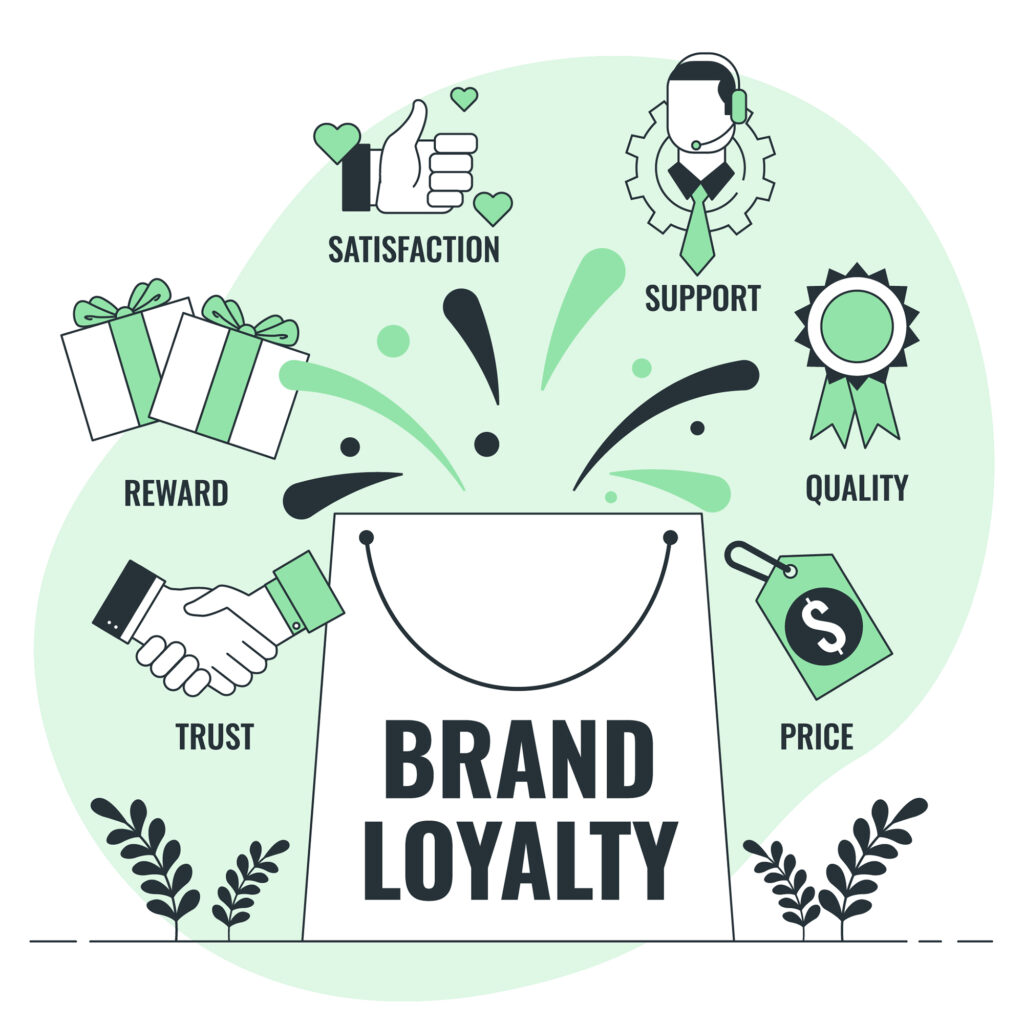In today’s competitive market, building brand loyalty is essential for long-term business success. Loyal customers not only drive sales but also advocate for your brand, providing free word-of-mouth marketing. But how do you build such loyalty? And what does brand loyalty even mean? In this guide, we’ll define brand loyalty, explore strategies to cultivate it, and provide real-world examples of brands that have mastered the art of customer loyalty.

What is Brand Loyalty?
Brand loyalty refers to a customer’s preference for a particular brand over competitors. When customers consistently choose your brand because of positive experiences, strong product quality, or emotional connections, they become loyal advocates. These customers are more likely to stick with your brand even when new alternatives are available, making them invaluable to the growth of your business.
Key Traits of Brand Loyalty:
- Repeat Purchases: Loyal customers repeatedly buy from the same brand, even if cheaper alternatives are available.
- Word-of-Mouth Referrals: They tend to recommend your brand to friends and family, amplifying your reach.
- Emotional Connection: These customers feel a connection to your brand that goes beyond the product or service.
Why is Brand Loyalty Important?
Building brand loyalty is crucial for several reasons:
- Increased Customer Lifetime Value (CLV): Loyal customers spend more over time and require less marketing to retain.
- Free Marketing through Advocacy: Customers who are loyal to your brand naturally promote your products to others.
- Resilience During Competition: Even if a competitor offers a cheaper product, loyal customers will stick with your brand due to trust and emotional connection.
- Lower Cost of Retention: It costs far less to retain a loyal customer than to acquire a new one.
How to Build Brand Loyalty
Building brand loyalty takes time, strategy, and a deep understanding of your audience. Here are some tried-and-tested ways to cultivate brand loyalty:
1. Deliver High-Quality Products and Services
The foundation of any brand loyalty strategy is delivering exceptional quality. If your product consistently meets or exceeds customer expectations, you lay the groundwork for long-term loyalty.
- Example: Apple has cultivated a fiercely loyal customer base by consistently delivering high-quality, innovative products like the iPhone and MacBook.
Pro Tip: Regularly ask for customer feedback to ensure that your product evolves according to customer needs and preferences.
2. Offer Excellent Customer Service
Great customer service can be the difference between a one-time customer and a loyal one. When customers know they can count on you to resolve issues quickly and efficiently, they’ll keep coming back.
- Example: Zappos, an online shoe retailer, built a loyal following by offering free returns and 24/7 customer service, ensuring that customers always feel supported.
Pro Tip: Invest in a responsive customer support system and train your team to handle issues with empathy and efficiency.
3. Build a Strong Brand Identity
Customers are more likely to feel connected to brands that have a clear identity. This includes your brand’s values, voice, and overall personality. A strong brand identity gives customers something to relate to emotionally, turning them into long-term supporters.
- Example: Nike’s “Just Do It” campaign is not just about selling shoes; it’s about promoting a mindset of perseverance and success, which resonates with its audience on a deeper level.
Pro Tip: Define your brand’s mission, values, and voice clearly, and ensure that they are reflected in all your marketing and communication efforts.
4. Create a Customer Loyalty Program
Rewarding your loyal customers is one of the easiest ways to keep them coming back. Loyalty programs, where customers earn points or perks for repeat purchases, give them an incentive to continue buying from you.
- Example: Starbucks’ Rewards Program allows customers to earn points with each purchase, which can be redeemed for free drinks or snacks, encouraging repeat visits.
Pro Tip: Make your loyalty program simple and rewarding. Offer meaningful incentives that your customers will value.
5. Engage Customers through Personalized Marketing
Customers appreciate brands that recognize their preferences and offer tailored experiences. Personalized marketing—whether through email, social media, or even product recommendations—can make customers feel valued.
- Example: Amazon excels at personalized marketing by offering product recommendations based on previous purchases, browsing history, and customer behavior.
Pro Tip: Use data analytics to understand customer preferences and create personalized experiences that resonate with their needs.
6. Stay Consistent
Consistency in delivering quality, messaging, and customer experience builds trust. When customers know they can rely on your brand to provide the same level of service or product every time, they’re more likely to stay loyal.
- Example: Coca-Cola’s brand consistency has allowed it to maintain a loyal customer base for over a century. From the product taste to the iconic red packaging, Coca-Cola delivers a consistent experience worldwide.
Pro Tip: Ensure that your brand maintains consistency in quality, customer service, and messaging across all channels.
7. Build a Community Around Your Brand
Creating a sense of community can help strengthen the emotional connection between your brand and its customers. Whether through social media groups, events, or forums, encouraging customer interaction can make them feel part of something bigger.
- Example: Harley-Davidson’s Harley Owners Group (HOG) creates a sense of belonging for its customers, making them feel like they’re part of an exclusive community.
Pro Tip: Use social media platforms, customer events, or loyalty programs to foster a sense of community around your brand.
8. Be Transparent and Authentic
Today’s consumers value honesty and authenticity. Brands that are transparent about their business practices, whether it’s pricing, sourcing materials, or handling crises, are more likely to earn and keep customer trust.
- Example: Patagonia has built brand loyalty through its commitment to environmental sustainability and transparency about its supply chain practices.
Pro Tip: Always be honest with your customers, even when things go wrong. Transparency fosters trust, and trust breeds loyalty.
Brand Loyalty Examples
Several companies have mastered the art of brand loyalty. Here are some real-world examples:
- Apple: Known for its high-quality products and customer-first approach, Apple enjoys one of the most loyal customer bases in the world. Their innovative products, coupled with a seamless ecosystem, have made them a customer favorite for decades.
- Amazon: Amazon has built customer loyalty by offering convenience, personalized experiences, and a reliable customer service system. Amazon Prime, with its fast shipping and exclusive perks, further solidifies customer loyalty.
- Tesla: Tesla has created an emotional connection with its customers through its mission to revolutionize transportation and promote sustainability. Tesla’s innovative products and community-driven approach keep customers highly loyal to the brand.
How to Build Customer Loyalty: A Step-by-Step Approach
Building customer loyalty takes time and strategy. Here are some actionable steps:
- Understand Your Customers: Conduct market research and gather customer feedback to understand what your audience values most.
- Deliver Consistent Value: Whether it’s through high-quality products, excellent customer service, or valuable content, consistently deliver what your customers expect.
- Engage Regularly: Keep customers engaged through social media, email marketing, and loyalty programs.
- Offer Incentives: Reward customers for their loyalty with discounts, exclusive offers, or early access to new products.
- Measure Success: Track key metrics like repeat purchase rates, customer lifetime value, and referral rates to assess the effectiveness of your loyalty-building efforts.
Conclusion
Building brand loyalty requires a combination of delivering quality, understanding your customers, and engaging them consistently. By creating emotional connections and offering rewarding experiences, you can turn one-time buyers into lifelong customers.
Incorporating loyalty programs, delivering personalized experiences, and being transparent are some of the most effective ways to foster brand loyalty. Just like brands such as Apple, Amazon, and Nike, your business can benefit from a loyal customer base that helps drive long-term growth.
Start implementing these strategies today and watch as your brand loyalty grows, creating advocates who choose your brand over all others.


